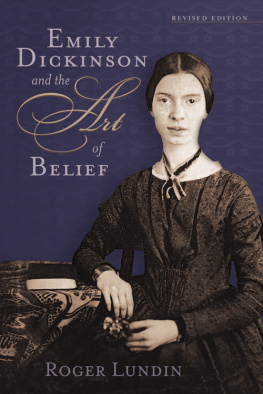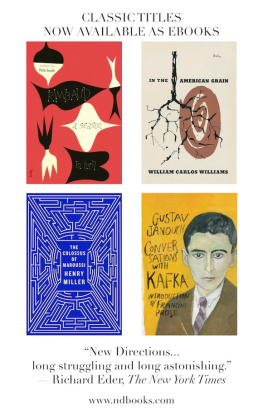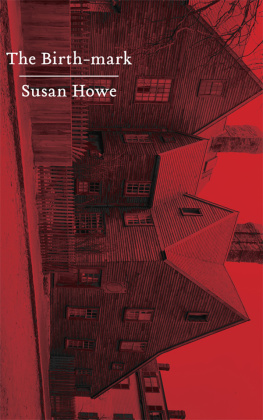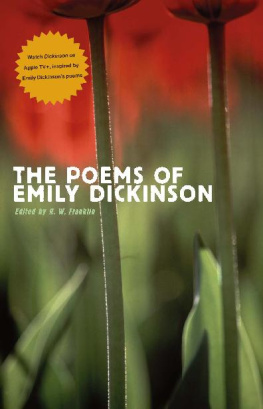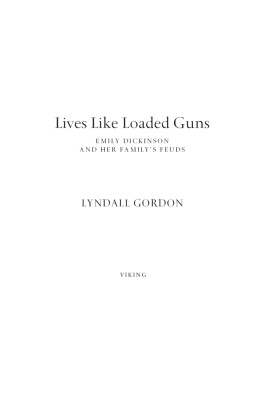Our Emily Dickinsons
Our Emily Dickinsons
American Women Poets
and the Intimacies
of Difference
Vivian R. Pollak

A volume in the Haney Foundation Series, established in 1961 with the generous support of Dr. John Louis Haney
Copyright 2017 University of Pennsylvania Press
All rights reserved. Except for brief quotations used for purposes of review or scholarly citation, none of this book may be reproduced in any form by any means without written permission from the publisher.
Published by
University of Pennsylvania Press
Philadelphia, Pennsylvania 19104-4112
www.upenn.edu/pennpress
Printed in the United States of America on acid-free paper
1 3 5 7 9 10 8 6 4 2
A Cataloging-in-Publication record is available at the Library of Congress
ISBN 978-0-8122-4844-9
For my students
at Brandeis,
Cheyney University in Pennsylvania,
the University of Pennsylvania,
the University of Washington in Seattle,
Washington University in St. Louis
And for Mia and Alex
Contents
Fr | The Poems of Emily Dickinson: Reading Edition. Ed. R. W. Franklin. Cambridge, MA: Harvard University Press, 1999. Citation by poem number. |
L | The Letters of Emily Dickinson. Ed. Thomas H. Johnson and Theodora Ward. 3 vols. Cambridge, MA: Harvard University Press, 1958. Citation by letter number. |
In an emotionally tense poem written when she was still in her early thirties, Emily Dickinson expresses this haunting thought about her role during the Civil War: It feels a shame to be Alive / When Men so brave are dead. Speaking as one, We, and I and as the possessor of a powerful conscience, she faults herself for escaping military martyrdom in Battles horrid Bowl. Expanding the trope, she claims to envy the modern heroes who died for liberty, the ground that holds their bodies, and the stones by which they are memorialized. This remarkable confession prepares for an even more disturbing conclusion. Although any kind of living is an achievement, a sort of fame, it is not Divinity. Divinity, Dickinson suggests, is what the Union dead achieve by dying. Because the poem is not well known, I will quote it in full:
It feels a shame to be Alive
When Men so brave are dead
One envies the Distinguished Dust
Permitted such a Head
The Stone that tells defending Whom
This Spartan put away
What little of Him we possessed
In Pawn for Liberty
The price is great Sublimely paid
Do we deserve a Thing
That lives like Dollars must be piled
Before we may obtain?
Are we that wait sufficient worth
That such Enormous Pearl
As life dissolved be for Us
In Battles horrid Bowl?
It may be a Renown to live
I think the Men who die
Those unsustained Saviors
Present Divinity (Fr 524)
It feels a shame to be Alive inhabits several kinds of ambition. The first is the most sociable. It responds to a specific national emergency. The second is more personal, more complexly gendered. Unable to perform the heroic deeds associated with men, the speaker feels guilty. This emotion is partly displaced from the dead to the sacred ground in which they lie and to the headstones by which they are memorialized. By implication, the speaker who craves intimacy with the dead also wants to write words that are publicly recognized and that last. This speaker wants to disinter, to resurrect, and to give voice to an unlived life from which ugly feelings have been banished, but the dashes tell the storythey interrupt the flow.
Suppose, then, that you are a person who thinks deeply about identities that have not yet been fully constituted. Suppose, too, that you are a person who wants to spare herself humiliation. What would it be like to compose It feels a shame to be Alive and to keep it to yourself? What would it be like to copy these publicly oriented words onto a sheet of paper and to use that sheet to conclude a poem sequence in which you declare This is my letter to the World (Fr 519)? What would it be like to keep that twenty-poem sequence, that Fascicle 24, in a locked box or dresser drawer and to make yourself your only continuously attentive reader? What would it be like to go back over that poem sequence and to take a poem from another fascicle, a poem about rewards, to recopy it, alter it, and to insert it into this newer grouping, while leaving the old one in its place (Fr 375, Fascicles 18 and 24)? What would it be like to be that brilliantly conflicted, that partly repressed, that angry, loving, home-keeping person, that Emily Dickinson?
The Dickinson I describe writes thinly descriptive poetry that refuses to satisfy the demands of her imagined audience for a fuller narrative of her life. If there is a center to what is by now the long history of Dickinson criticism, it is this: readers are curious about the person behind the poems. Although she did write, When I state myself, as the Representative of the Verse it does not mean me but a supposed person, the women poets who interest me most deeply have been reluctant to separate the life and the work so neatly (L 268). Reading for both text and context, they are interested not only in Dickinsons literary self-expression and fictionalized persona but also in her psychological intimacies and social sources.
Dickinsons psychological ambivalence about her relationship to her actual and potential readers has been well established and continues to be documented with precision. I argue that this ambivalence, however productive, has significantly influenced her reception. It has interrupted what we might think of as a coherent genealogy of American womens poetry. Such a genealogy would transmit ideas from one generation to the next. It would demonstrate incremental continuity and patient connections intimately forged. In all probability, it would disseminate an idealized version of mother-daughter relationships and would reinforce the romance of what a later poet (Muriel Rukeyser) calls group culture.marked by the sexual politics of the mid-twentieth century. I will look more closely at Muriel Rukeysers hybrid manifesto,The Life of Poetry (1949).
In this underread classic of feminist critique, Rukeyser takes her time before mentioning Dickinson. Indeed, she is about a third of the way through the text when she glances at Dickinsons rhythms, which she compares to those of the muscular Gerard Manley Hopkins (briefly) and to those of the self-poised Walt Whitman (more extensively). Emily Dickinsons strictness, she writes, sometimes almost a slang of strictness, speaks with an intellectually active, stimulated quick music. Yet it is Whitman who offers us the rhythms of resolved physical conflict. When he says, I have found the law of my own poems, he celebrates that victory. From this perspective, it is apparent that Dickinson has not yet found the law of her own poems; she is still a poet in search of her fullest self. She is waiting to be liberated from the anxieties of audience which arrest her. Her rhythms represent the problems of the confined female self and of its access to cultural power. My point is that thinking about Dickinson makes Rukeyser uncomfortable. Recalling her own professional frustrations, she moves quickly into an irate account of her troubles as a biographer of J. Willard Gibbs, the nineteenth-century American physicist who was one of her culture heroes and whose genius, she believed, was overlooked. Like Dickinson, she was almost silenced, but Rukeyser has other versions of Dickinson in reserve.
Next page

